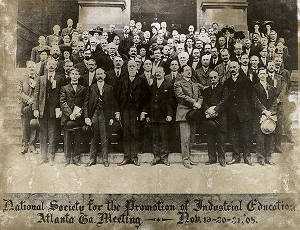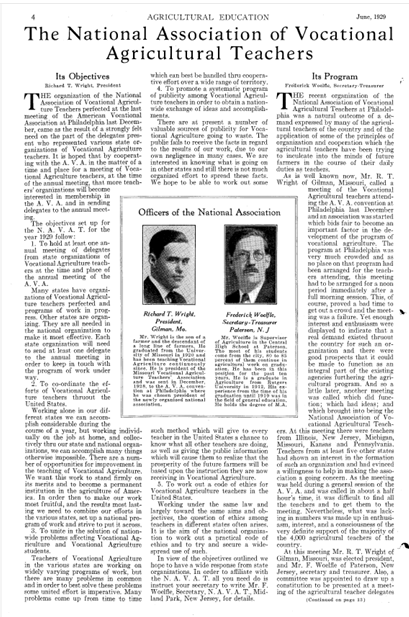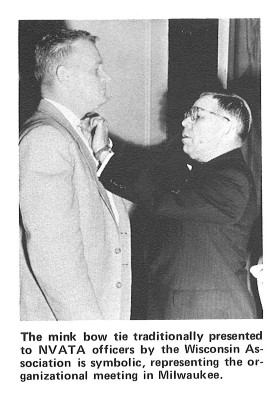We momentarily interrupt our alphabetical listing of agricultural education in the various states to wish the NAAE (NVATA) a happy 75th birthday. At the recent NAAE & ACTE convention in Phoenix there was a nice birthday celebration to commemorate the 75th anniversary of the founding of NVATE/NAAE. In this Footnote we will briefly review the history of the National Vocational Agriculture Teachers Association, now known as the National Association of Agricultural Educators.

One Sidenote: At the recent convention one person told me they printed each Friday Footnote and saved it in a folder. That is great but there is an electronic index of all past Friday Footnotes. If you go to the Friday Footnote archive site (https://footnote.wordpress.ncsu.edu/) and scroll to the bottom of the page, you will see:

Just click on that link and you will find a complete listing with links to all past Friday Footnotes. Also you should be aware there is a search box on the Friday Footnote site where you can search for specific words such as Alabama, NFA, Groseclose, creed, etc. Now, on with our birthday celebration.
Change was Needed…
In the early 1900s the public was disgusted with schooling. It was primarily classical and didn’t put much emphasis on practical education for life or the emerging industrial society. To address this deficiency a group of concerned industrialists and progressive educators banded together in 1906 to form the National Society for the Promotion of Industrial Education. The first convention of the Society was held in Chicago in January of 1908. The aim of the society was to promote the teaching of industrial subjects including agriculture and home economics in the schools. They also advocated for legislation to promote what they labeled as industrial education.

Figure 1. The 2nd Convention of the NSPIE was held in Atlanta in December of 1908.
A similar group, the National Society for Vocational Education of the Mid-West, was organized in 1914. The two Societies were successful as evidenced by the start of vocational education in numerous states and culminating with the passage of the Smith-Hughes Act in 1917. The Smith-Hughes Act created a Federal Board for Vocational Education which employed subject matter specialists in the various fields of vocational education.
In 1926 the two groups mentioned above merged to form the American Vocational Association (AVA). Along with the vocational education specialists employed by the Federal Board, the AVA provided national leadership for the emerging field of vocational education and the various vocational disciplines.
There was not a need for discipline specific vocational teacher organizations because each vocational discipline was a division of the American Vocational Association and operated somewhat autonomously under the big AVA umbrella.
A Good Idea but…
Some individuals believed there should be discipline specific vocational teacher organizations nationally. In numerous states, vocational agriculture teacher organizations were created before and after the passage of the Smith-Hughes Act. At the AVA convention in Philadelphia in 1928 a group of teachers met and organized the National Association of Vocational Agriculture Teachers (NAVAT). Richard Wright of Missouri was elected president and Frederick Woelfle of New Jersey was elected secretary and treasurer. A committee was appointed to write a constitution to be presented at the AVA convention in 1929 in New Orleans.
The theme for the June 1929 issue of The Agricultural Education Magazine was Professionalism and Professional Organizations. A little over two pages were devoted to the newly created National Association of Vocational Agriculture Teachers.

Figure 2. Article from the June 1929 issue of The Agricultural Education Magazine
At the 1929 AVA convention a small group of teachers met and discussed whether or not the NAVAT should continue to exist. Most of the real work of an agriculture teacher’s association was being carried out at the state level, and it was questioned if a national organization was needed. To further compound the situation the number of teachers attending the AVA convention was small and different teachers attended each year. Within two years the NAVAT ceased to operate. It is possible the great depression also contributed to the demise of the NAVAT.
If at First You Don’t Succeed…
For the next 18 years the Agricultural Education division of the AVA continued to provide leadership for the profession and represented the agriculture teachers, state supervisors, and teacher educators. However, the state supervisors and teacher educators dominated the division. At the 1947 AVA convention in Los Angeles the issue of having a national organization for the teachers emerged. Even though opinion was divided a large majority favored the idea and plans were made to make a final decision at the 1948 AVA convention in Milwaukee.
A planning group met immediately prior to the 1948 AVA convention and developed plans for a national agriculture teacher’s organization. It was believed that a national organization would develop professional pride, promote a spirit of unity in the classroom teachers, improve the welfare of the teachers, and encourage the development of vocational agricultural education.
During the 1948 AVA convention Leslie Jackson of Idaho made a motion to organize a national association of agriculture teachers to be known as the National Vocational Agriculture Teachers’ Association. “Hap” Hazard of Arkansas seconded the motion which was carried by a wide margin. Approximately 100 agriculture teachers from 30 states were at this initial meeting.
Lionel Cross of California was elected president and Jess Smith of Wisconsin was named treasurer. Thirty-three state associations affiliated with the national organization during the first year. And, as is often said, the rest is history. A book could be written about the growth of the NVATA since then and was. It was titled Professional Leadership and Service and covered the time period 1948-1973. Sam Stenzel and James Wall were the authors.

Figure 3. To commemorate the founding of the NVATA in Wisconsin, mink bow ties were given to the early NVATA officers by the Wisconsin Ag Teachers Association. Image from Reference 3 below.
We really do need to document the changes that have occurred in the NVATA since 1973. For example, the NVATA changed their name to the National Association of Agricultural Educators (NAAE) in 1997 at the Las Vegas convention. The national headquarters has moved from California to Nebraska to Virginia to Kentucky. And there have been many more changes.
The NAAE had close to 1,000 attendees at the recent Phoenix AVA/NAAE convention. This was a far cry from agriculture teacher attendance at the early AVA conventions. The NAAE is doing great things and has numerous professional development sessions at the convention and a robust awards program. If you haven’t attended a NAAE convention, plan to do so in 2024 (December 3-7) in San Antonio. Let’s break the 1,000 attendance mark! Check the NAAE web site for more information.
Next week we will resume our study of states with “H” is for Hawaii.
References
The Agricultural Education Magazine, April 1966, Volume 38, Number 10 has numerous articles about NVATA history.
The NAAE web site – https://www.naae.org/
Stenzel, Sam & Wall, James (1973). Professional Leadership and Service, 1948-1973. Published by the NVATA.
